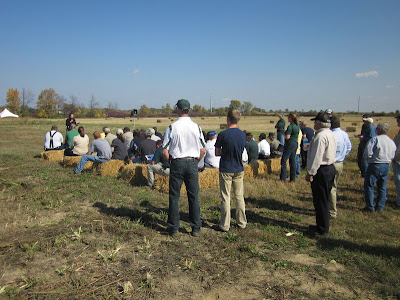So yesterday Doug and I went to the Bioenergy, Cover Crops & Corn Residue Management Field Day. Now that's quite a title, so there should be lot's to see. There was. It was put on by MSU Extension and there is a new research farm for this not to far from the NCRS. It was a beautiful day, and there was a good turnout. It had rained the night before, so not much soybean harvesting going on at the time. Below our County Extension Director Marilyn Thelen gives the welcome and introductions. There were a lot more people there than the picture shows.
They showed some of the grasses being used for energy sources: Switchgrass, Indian grass and Miscanthus, the tall grass in the background. They also had Big and Little Bluestem.
I'll bet I was the only one in the crowd that knew that Indian grass is the state grass of Oklahoma. Or that knew the scientific name of Sorghastrum nutans. (I knew that would come in handy someday.)
They also showed how to extract seed oil and make some of your own biodiesel. Now it isn't very economical, but they mentioned the reduction of dependence on foreign oil. Take that Canada! (By far our leading imported oil source.)
Then they had a demonstration of a grass pellet mill for making pellets as a fuel source. This one was making switchgrass pellets. But they said they had worked on the recipe where they had the best results with addition of a little grass from another source and some sort of chemical moisture source source to enable the pellet to stick together.
They opened the cover and you can see the pellets being pushed out. They are very hot here, and they go up a cooling ramp, seen in the picture above, before they are dropped out. Otherwise they would stick together or something bad. But they come out in nice pellets suitable for burning, like in those stoves for home use.
They also showed baled switch grass. These bales were going to be taken to the MSU powerplant that uses coal. So this would be a coal replacement, or additive. Now they said it takes about 3 years to get a field up and producing to the max. For fuel bales like this, you can get around $72 per ton, and a decent yield is 6 T/year. They said it really only needs about 70 pounds of N per year as the P and K goes back down into the roots before it is cut. (We may want to see if Liquid fertilizers will improve production. Stay tuned.) They didn't really talk about switchgrass as an ethanol source though. Or maybe I was still looking at the Indian grass.

They also had some vertical tillage demonstrations. The closest one is a manure applicator where you could also mix in covercrop seed. Due to an unfortunate high-pressure broken hose incident at a field day a few years ago, which I witnessed, they now do these demonstrations with water instead of manure. They also had equipment from Salford, Krause and Landoll. Like fertilizer, each manufacturer said theirs was the best.
One thing I found interesting was the harvest demonstrations. They had a combine that had Calmer BT Choppers on it. It is for cutting up corn stalks as part of residue management. I had heard of them, but had never seen one in action. Here is a view under the corn head.
There were no stalks on the ground. They were all chopped up. The field was very clean.
Here is what happened to the stalks. Just short pieces that should break down quicker. Interesting. They also had another attachment with rotary mower blades under the head. But I liked the Calmer version here.
I guess if you come out having learned some things, then the field day was a success. It was.


























































